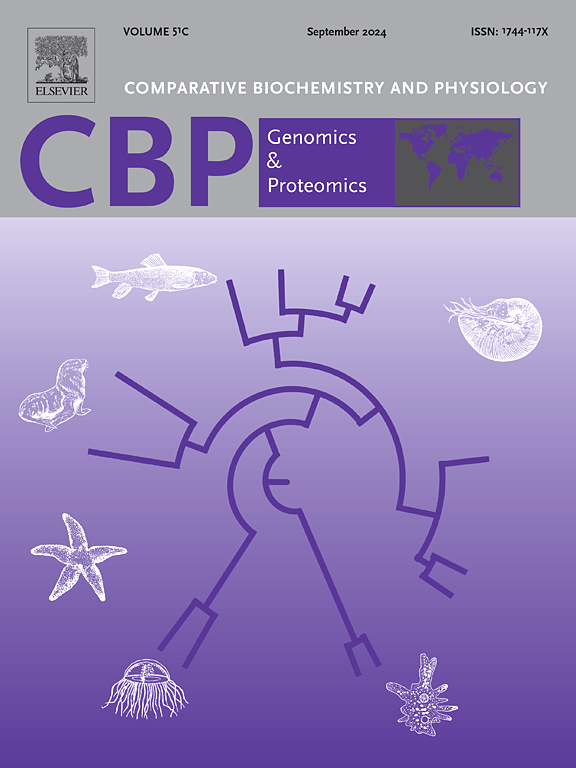Transcriptome analysis reveals the potential mechanism of plateau environment on muscle growth and development in yak
IF 2.2
2区 生物学
Q4 BIOCHEMISTRY & MOLECULAR BIOLOGY
Comparative Biochemistry and Physiology D-Genomics & Proteomics
Pub Date : 2024-12-09
DOI:10.1016/j.cbd.2024.101395
引用次数: 0
Abstract
Yak meat plays a significant economic role for yaks. The unique environment of the Qinghai-Tibet plateau profoundly impacts the meat production performance of yaks. Yet, the regulatory mechanisms influencing muscle growth and development in yaks within this plateau environment remain poorly understood. The study investigated the transcriptome gene expression in the buttock muscle tissue of yaks residing at varying altitudes. It revealed 516 differentially expressed genes in the buttock muscle tissue of yaks at high altitude (4500 m) and low altitude (3000 m). The Gene Ontology (GO) annotation indicated that these differentially expressed genes primarily function in RNA binding, identical protein binding, nucleotide binding, pre-mRNA branch point binding, unfolded protein binding, insulin receptor binding, fructose 1,6-bisphosphate 1-phosphatase activity, collagen binding, platelet-derived growth factor receptor binding, and sodium channel inhibitor activity. Kyoto Encyclopedia of Genes and Genomes (KEGG) pathway analysis revealed that the differentially expressed genes predominantly participated in pathways such as the spliceosome, aminoacyl tRNA biosynthesis, RNA polymerase, cutin, suberin, and wax biosynthesis, ribosome biogenesis in eukaryotes, plant hormone signal transduction, axon guidance, fructose and mannose metabolism, pentose phosphate pathway, and gastric acid secretion. This study unveiled the impact of the plateau environment on transcriptome gene expression in yak buttock muscle tissue, mapping out the gene expression profiles specific to yaks living at varying altitudes (3000 m and 4500 m). The findings offer crucial genomic insights into the mechanisms behind yak muscle adaptation to plateau environments.

转录组分析揭示了高原环境对牦牛肌肉生长发育的潜在影响机制。
牦牛肉在牦牛的经济中扮演着重要的角色。青藏高原独特的生态环境深刻影响着牦牛的肉品生产性能。然而,高原环境下影响牦牛肌肉生长发育的调节机制尚不清楚。研究了不同海拔地区牦牛臀部肌肉组织中转录组基因的表达。结果表明,高海拔(4500 m)和低海拔(3000 m)牦牛臀部肌肉组织中存在516个差异表达基因,基因本体(GO)注释表明,这些差异表达基因主要在RNA结合、同蛋白结合、核苷酸结合、pre-mRNA分支点结合、未折叠蛋白结合、胰岛素受体结合、果糖1,6-二磷酸1-磷酸酶活性、胶原蛋白结合、胰岛素受体结合等方面发挥作用。血小板衍生生长因子受体结合和钠通道抑制剂活性。京都基因与基因组百科(KEGG)途径分析显示,差异表达基因主要参与剪接体、氨基酰基tRNA生物合成、RNA聚合酶、角质、亚木素和蜡质生物合成、真核生物核糖体生物发生、植物激素信号转导、轴突引导、果糖和甘露糖代谢、戊糖磷酸途径、胃酸分泌等途径。本研究揭示了高原环境对牦牛臀部肌肉组织转录组基因表达的影响,绘制了生活在不同海拔(3000 m和4500 m)的牦牛的基因表达谱,为牦牛肌肉适应高原环境的机制提供了重要的基因组见解。
本文章由计算机程序翻译,如有差异,请以英文原文为准。
求助全文
约1分钟内获得全文
求助全文
来源期刊
CiteScore
5.10
自引率
3.30%
发文量
69
审稿时长
33 days
期刊介绍:
Comparative Biochemistry & Physiology (CBP) publishes papers in comparative, environmental and evolutionary physiology.
Part D: Genomics and Proteomics (CBPD), focuses on “omics” approaches to physiology, including comparative and functional genomics, metagenomics, transcriptomics, proteomics, metabolomics, and lipidomics. Most studies employ “omics” and/or system biology to test specific hypotheses about molecular and biochemical mechanisms underlying physiological responses to the environment. We encourage papers that address fundamental questions in comparative physiology and biochemistry rather than studies with a focus that is purely technical, methodological or descriptive in nature.

 求助内容:
求助内容: 应助结果提醒方式:
应助结果提醒方式:


